I recently read an account of an English couple's wedding in Crete. Each person's wedding is a very personal affair, but there was a nagging feeling at the back of my mind that the wedding in question was anything but a Cretan wedding. Two non-Cretans, with no family in the area, wishing to marry in a civil ceremony, whose biggest worries were the picturesqueness of the scenery, being on schedule for mani-pedicure appointments and whether noise pollution from the nearby airport would spoil their big day; this scenario contains none of the elements of the traditional staging of a Cretan wedding.
A typical traditional Cretan wedding is a large scale event. It often starts at a village church, usually in a remote or very scenic setting, and ends up at a large function hall where the primary emphasis is not on décor, but on space; a traditional Cretan wedding usually involves more than 500 guests. The most important aspect of these function centres is capacity, so that all the guests can fit in comfortably and the food can be served efficiently. In the past when life was a lot simpler and function halls did not exist, weddings were held in the village square, while guests bought the chairs and tables from their own houses. Globalisation has taken care of aspects such as this one, and weddings in Crete can be as simple or as complicated as your purse can afford, an inevitable sign of progress. Weddings may have become more and more elaborate over the last few years, but the basic principles have not changed.
We were recently invited to a wedding in Hania. The church service took place in a lush green beautiful setting not far from where we live.
Traditional weddings in Crete are an orchestrated event of food and music. The bride and groom play their own roles in this orchestration. They are not the main attraction; they are the motivation behind an opportunity given to all parents to organize a day when the whole family, nuclear and extended, even entire villages, come together to celebrate a union between two people. A commonly said joke is that if those two people had asked anyone if they shouldn’t get married, there’d be no event at all...
The important role in a Greek wedding is played by the koumbaro, the best man (who could also be a woman – koumbara). This is the person that ‘marries’ the couple; the priest is simply the religious representative. The koumbaro is always treated like a member of family for the rest of his life. The number of wedding guests swells because not only are the bride’s and groom’s families invited, but the koumbaro also has the right to invite guests to the wedding. The more guests, the more food; the more food, the more expensive a wedding becomes. But the reception costs are often indirectly met by the guests themselves. Bridesmaids and page boys are not at all common. Bridal stores toss in a flower girl’s dress for free – it’s included in the price of hiring the costly wedding dress; a bride typically spends about 1500 euro to hire one. Some brides are now getting their wedding dresses made at an even more expensive price, a sign of the materialistic times we live in.
Once the priest has chanted “kai i gini na fovatai ton andra” (the wedding liturgy surely needs to be rewritten to say something like "kai o andras na fovatai tin gini"), the koumbaro has crowned the bride and groom with the stefana, and the couple has taken their first steps together in Isaiah’s dance (the couple makes no vows to each other in the Greek Orthodox wedding service, which sounds good for those with committment problems), the bride and groom stand next to the koumbaro, along with their close family members, lined up outside the church, and are blessed by their guests with the phrase ‘Na zisete’ (a wish for long life) and a small business-card sized envelope (fakelaki) containing their ‘gift’, which is placed on a silver tray (diskos). Cretans are still used to being given money for their wedding.
The Western fashion of a wedding list at an expensive home store is also catching on, but it’s still not very popular; in any case, it only makes sense to pass on some money (hidden away in an envelope which you can choose to sign your name on) to the couple when you consider how the wedding reception is organized. The cheapest function centres will charge about 20 euro per guest, but there are also the hidden costs: at this price, the wine, raki, xerotigana and musicians are not included; the bride's rented dress is usually paid for from the guests' monetary gifts. The tradition of marrying in a church is still strong in Greece, maybe because of family pressure, but also because it's what people like and prefer. Greeks prefer to get married in a church rather than the mayor's office, whether or not they had known each other before they got married (in the old-fashioned biblical sense). They will have set up their new home before they get married, so they may already be in debt for this reason, and will be hoping that the proceeds of the wedding will help them to pay off some of the expenses. In any case, it makes better sense to give the couple money so that they can spend it on their choice and taste in material goods rather than end up with ten coffee makers which they have to return to a store and exchange.
The wedding favours consist of boubouniera, usually a tulle pocket containing some koufeta, which are candy coated almonds traditionally associated with weddings all over Europe. Cretan wedding bread is part of the traditional offering to guests, as well as xerotigana, a fried pastry sweet coated in honey syrup. The kouloura is considered optional, but the koufeta and xerotigana are never missing from a wedding in Hania. The wedding in question used a clever combination of koufeta and kouloura, omitting the usually wasteful part of the tulle pocket.
Food is not chosen randomly for this event; the menu is pretty much fixed and has been this way, with very few changes, for the last few hundred years. Guests know what to expect to see on the table as they arrive at the function, and what the main dishes are. Very few people will stray from the set menu; they may add some extra items, to make their wedding appear more luxurious, other food items, but some things are never replaced or omitted. Even those with small pockets will endeavour to provide the parts of the menu that have always been included in a traditional Cretan wedding feast.
This is a typical table set up at a Cretan wedding reception hall; the folded napkins in the glass and the tablecloths show that it's upmarket. When a large enough reception centre isn't available, traditional weddings are held in a village square, as they were in the past, which also explains why weddings were (and still are) usually held in the summer (the month of May is said to be when only donkeys and kings get married, while people also avoid marrying in leap years (pregnant brides excepted). The xerotigana may optionally be handed out either at the church or the reception (as here).
After the guests greet the couple, they pick up a boubouniera (the favours passed on to the guests), the first food offering, a small tulle pocket containing sugared almonds. This may be accompanied by a wedding kouloura (traditional Cretan wedding bread) and/or xerotigana, the traditional Cretan wedding sweet, which consists of fried pastry rounds, dipped in syrup and sprinkled with finely ground walnuts. This dessert is completely vegan, so it is a miracle that it made its way into one of the most carnivorous food events in Crete. Even though they are in essence a lenten food item, xerotigana aren’t ever made during fasting periods because of their joyous connotations. If the xerotigana and/or kouloura weren’t given away with the boubouniera after the church service, then they're bound to be waiting for you at the reception centre.

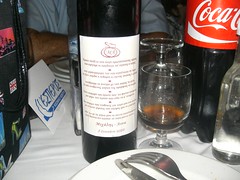
The table will be decked out with drinks and hors d'oeuvres. It's important to know where to sit at such a large function: we were invited by the koumbaro (the best man), so we sat at the tables that were marked out for his friends and family. We did not know the bride and groom at all, although we did meet up with them by chance a month before their big day, which just goes to show, it's a small world...
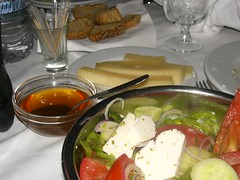
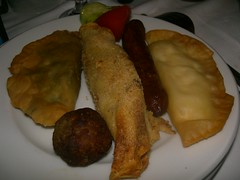
Here's what you'll find set up at the tables of the reception hall: sweet biscuit rusks, graviera cheese, honey, and an individual serving of traditional appetisers. The salad is sometimes bought during the later courses of the meal. The appetisers consist of traditional Cretan mezedakia. Click on the photo on the right hand side to see the notes.
After the church service, modern couples choose to go to a photography session, while the guests continue on to the function centre. The guests are often kept waiting for a while until the bride and groom arrive. This is (supposed to be) a once-in-a-lifetime event, so it's just part of the game. While the guests are waiting, some parts of the lavish meal are being served. The table is set for a lot of eating and drinking. There will be a bottle of wine, a bottle of water, a carafe of tsikoudia and some soft drinks. Don't go in search of beer; that'll be found in a modern (rather than a traditional) Cretan wedding (pregnant bride included). Food-wise, the first thing guests look for is the xerotigana. Always bring a plastic supermarket carrier bag with you to pick up your share of them - this delicious delicacy is hardly ever eaten at the reception; it becomes breakfast, dessert, and coffee time sweet at the guests' home the next day.
There is usually a little plate of appetisers (individually served to each guest) which includes Cretan specialties like kalitsounia and locally made country-style sausages. The more upmarket places will serve these to you freshly, while others may leave the plates on the table before the guests arrive, covered in plastic wrap (you get what you pay for). The offerings represent the age-old tradition of serving the 'best' food on a day of celebration, and the best cuisine Crete has to offer is in these unique pastries. They may not seem like haute cuisine, but they are some of the finest quality (not to mention unique) food items Crete has to offer. Think about how developed societies view honey, cheese and pastry sweets; you'll understand the offerings much better in this light. There will be a plate with a few thickly sliced rods of graviera, a little bowl containing honey with a spoon and a plate of sweet paximathia. The cheese is dipped into the honey before being eaten. This is a special wedding tradition, but it's not as unusual as it sounds: honey is often poured over Cretan cheese pies.
As the bride and groom (finally) enter the reception area (you're bound to hear shotguns being fired at this point), the traditional Cretan wedding march is played by the band, while the couple are 'honeyed': the bride is fed a spoonful of runny honey mixed with walnuts. Honey is seen a symbol of love and tenderness, a way to 'soften' the bride to accept her new role in a predominantly patriarchal society. This tradition is slowly dying out, due to the messy trails that honey leaves on a bride's perfectly made-up face and once-in-a-lifetime dress, and possibly the greater equality between the sexes. The couple could have fun honeying themselves after the event if they're that desperate...
Some formalities are taken care of at this point. A western-style wedding cake is cut (but not served at this moment), along with the modern custom of opening up a bottle of bubbly. Guests who couldn't make it to the church but came only for the reception line up to bless the happy couple, leave their fakelakia and pick up their boubouniera. This takes a while; traditional weddings entail whole village communities going through these motions. Once it's over, everyone starts clicking the cutlery against their glass to see the bride and groom take their first kiss. The couple at the wedding in question either forgot to do this or didn't want to, despite their audience's pleas; maybe they were both simerinoi (ie they were born yesterday)...
As this meal is a purely carnivorous celebration, the meat that is served is generally given the name of its cooking style. The first lamb to come on the table is the vrasto, the boiled meat (you read that correctly - plain boiled meat), accompanied by the pilafi, rice cooked in the strained broth of the boiled meat. Don't expect to see pilafi at a wedding in Iraklio - they serve spaghetti cooked in the meat broth there. It is so unrefined (read: slurp, slurp, slurp); there is nothing like Cretan wedding pilafi. Pilafi at weddings is always tasty, due to the quantity and quality of meat used.
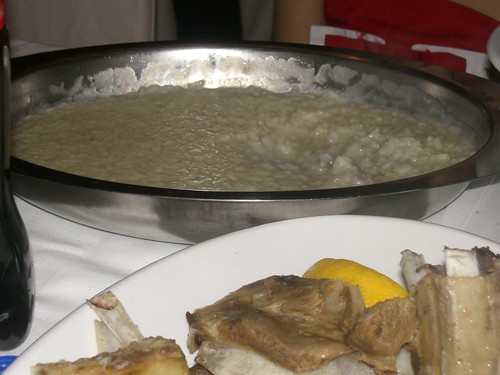
Pearly creamy pilafi is THE wedding food in Hania, followed by roast meat and potatoes. This wedding was a little more lavish, serving tsigariasto with some fried potatoes as part of the appetisers. Vegetarians are not catered for in any way. It really was a shame that so much meat was served, because the roast remained untouched on our table; a lot of food is unfortunately wasted. People used to come hungry to these events; nowadays, our stomachs are full before we even get to the church...
The second meat dish to be served is the psito, the roast meat, accompanied by roast potatoes and a salad. If the reception is a lavish one (like the one we went to), then there may also be another meat dish served, like tsigariasto, braised lamb or goat in plain olive oil. This is purely optional; the vrasto-pilafi and psito-potatoes are mandatory. The meat is visible, and cooked in the simplest fashion. There is nothing fancy about wedding meals in Crete, so that means that the meat must be of very high quality - very fresh, not fatty and plentiful. The world may have become more complicated over the centuries, but Cretan weddings retain the element of timelessness, as if nothing has changed...
The groom is a traditional Cretan musician, so we were treated to a lot of traditional Cretan songs, music and dancing. A special dancing troupe from Apokoronas (the groom's birthplace) performed a show of Cretan dancing; the traditional Cretan dress (in both the man's and woman's case) is sometimes worn in place of the Western style wedding outfits. The bride and groom were the first to dance, starting off the party with a traditional Cretan wedding dance. No other music genre was heard on this night, which may have to do with the fact that both the groom and his father (he was playing in the band) have been involved in the traditional Cretan music scene all their life. What's with the fireworks, you may be asking. Well, you can't fire a gun indoors, can you? (it's also been outlawed in any case).
The food is served slowly enough to digest it throughout the evening at a leisurely pace. There is no rush to eat quickly at this event. In any case, the bride and groom are the last to leave their wedding (not the first, as in the West), and dancing is just as important as the food - a Cretan bride is expected to dance with every single one of her guests (though not everyone gets up to dance). Cretan music will be performed throughout the night. Foreign music (ie pop and rock songs) aren't actually a part of a traditional Cretan wedding, although it is often heard in the modern version of a Cretan wedding (the one with the pregnant bride).
Dessert consists of the creamy 'pasta' style wedding cake. This is often followed by fresh fruit. There is usually no room for much else by this time. If you were saving your appetite for the chocolate fountain, you'll be immensely disappointed to find out that there is no such thing at a Cretan wedding, no matter whether it's traditional or modern; this is Crete, remember. But you do get to take home a few gifts - the boubouniera, the kouloura, the xerotigana, and in our case, the wine bottle which had a poem specially dedicated to the happy couple in question.
The next time someone tells you that they got married in Hania, you'll know to ask them if they like the xerotigana and the pilafi, because without those two items, it's not a Cretan wedding, is it?
And if you exclude the traditional Cretan dancers and the kouloura, my wedding a decade ago was no different.
©All Rights Reserved/Organically cooked. No part of this blog may be reproduced and/or copied by any means without prior consent from Maria Verivaki.
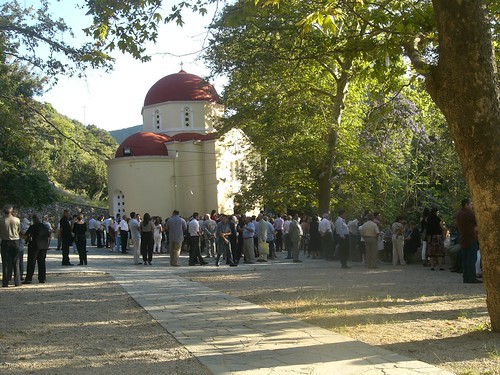

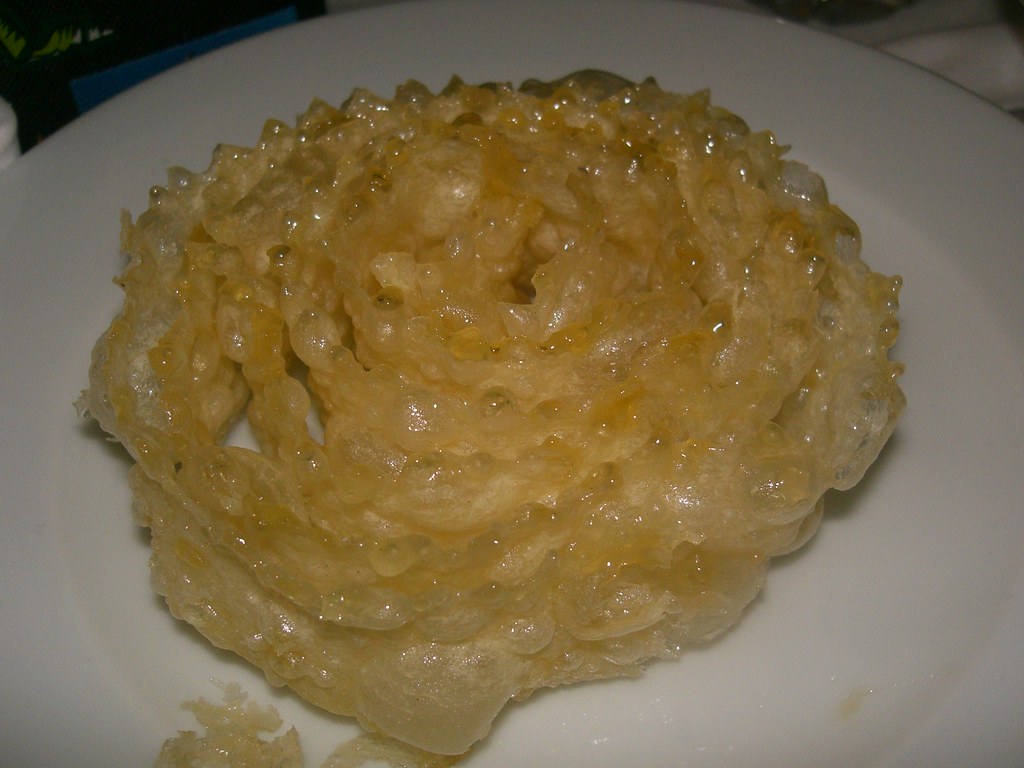


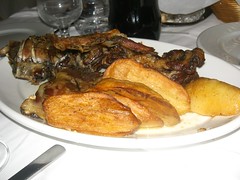


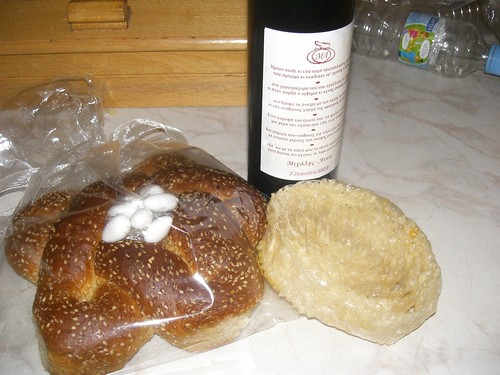
I'm going to my second Cretan wedding next month, I'm so looking forward to it! As it's my own daughter's wedding the following month in Wales I think I shall have to starve afterwards.
ReplyDeleteBeautifully described Maria, I have attended a lot of Cretan weddings and they were all similar to this one. The Cretan wedding tradition is so lovely, isn't it?
ReplyDeleteWonderfully explained Maria! Oh! And I love Cretan dancing. Greek weddings held in Australia are very expensive affairs with a lot of showing off! A great read!
ReplyDeleteAll the best to the young couple. Excellent wedding reporting Maria!!
ReplyDeleteFascinating Maria. Lots to mull over.
ReplyDeleteExplained beautifully. Thanks for sharing...I love weddings and and always eager to learn about different customs in different regions. Love the video!
ReplyDeleteOh my gosh! Cretan weddings sound spectacular! I think this is my favorite post you've made. I LOVE learning about stuff like this. I could picture it in my head as you described all the different parts. I love how you described the wedding ceremony, and the reception afterwards, too. The food sounds wonderful (Italians have wedding soup ... the meaning of which is splurging on ingredients: meatballs, chicken, pasta, egg, veggies, and cheese all in one soup. Mmmm, mmmm, mmm ... it's so good!) I love the bit you described about the bride being served a spoonful of honey and nuts.Growing up, I absolutely, thoroughly enjoyed attending the Italian weddings of my relatives. EVERY relative attended and it was so much fun for kids as well as adults. I was a young adult before I attended a non-Italian wedding and I was shocked at how different it was. It was a friend of the family, and consisted of a chruch wedding and dinner reception. Oh, the bride was beautiful and the hall was fancy and the food was good, but the atmosphere was just so different from the ethnic based weddings I was accustomed to. My wedding was decidedly Italian, complete with relatives, dancing the Tarantella, and traditional food. Ah, Cretan weddings sound amazing, and I bet they are a memorable, joyous affair for all who attend! :-)
ReplyDelete:-D This brings back memories...Να ζήσουν τα παιδιά... Crete has great customs surrounding the wedding ceremony (and great food as well :-D :-D )
ReplyDeleteGreat post - Cretan weddings are always a lot of fun and great for catching up ...just love them, but sometimes a lot of the food, especially the meat, goes to waste as it gets returned untouched...wish they would look out for an orphanage or other needy establishments that could use such untouched leftovers...
ReplyDeleteI love Greek weddings steeped in tradition and with some organization. The best ones have an eye to tradition.
ReplyDeleteI've only gone to a wedding with the bride being Cretan but the glenti is wonderful!
I went to a Cretan wedding almost 2 years ago. It was near Irakleio and it did serve the wedding rice dish. it was the first time I had had that before. You are right about the meat as well! Lots of it!
ReplyDeleteIt's like we were all there with you! Love traditional weddings and I am sure this one was a lovely one. I have heard so much about the pilafi served in Crete and it's importance but I have yet to have the pleasure to taste some traditional Cretan pilafi.
ReplyDeleteI've got to say I love the favors and invitations. Well, and the idea of money instead of a gift list.
ReplyDeleteWhat a wonderful post! I will have to reread this several times to really absorb all of the details. I was nodding in agreement when you noted that the bride and groom were not the main attraction in a wedding; at my wedding, the many of the guests were my parents' friends and colleagues. It was a good reason to gather and reinforce important social connections.
ReplyDeleteI need to be invited to a Cretan wedding so that I can have a xerotigana!
I want to have a Cretan wedding. It looks SO fun!!!!
ReplyDeletenice
ReplyDeleteDear Friends,
ReplyDeletei believe that if you want to make the ideal wedding in chania, the best expert there is Eleni Mavrogeni. She makes really unique weddings and she creates handmade items. You can visit her website at http://www.weddingincrete.gr. You can use my name if you want.
Happy Weddings!!!!!